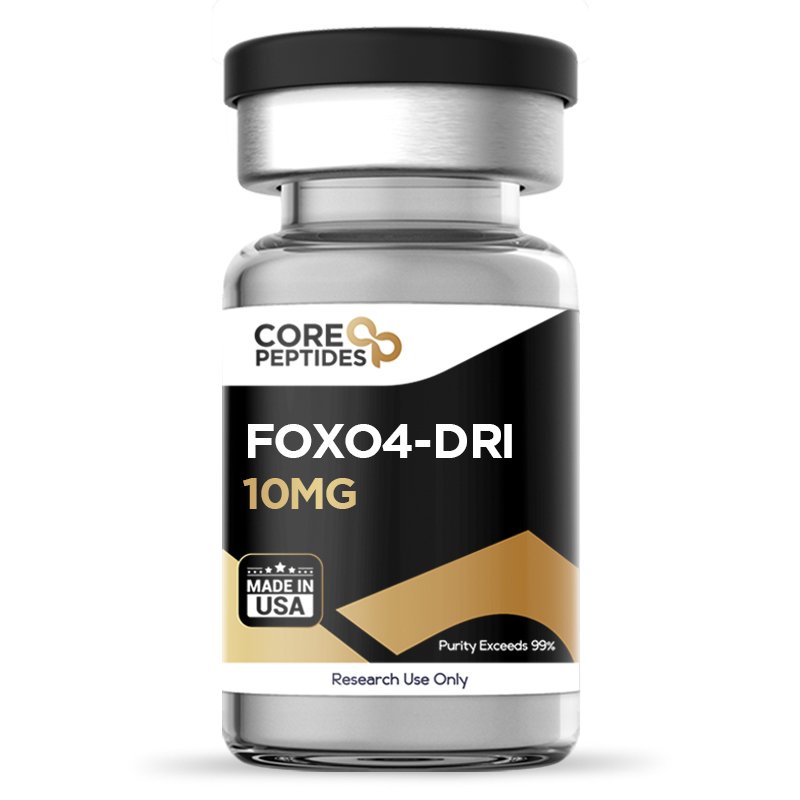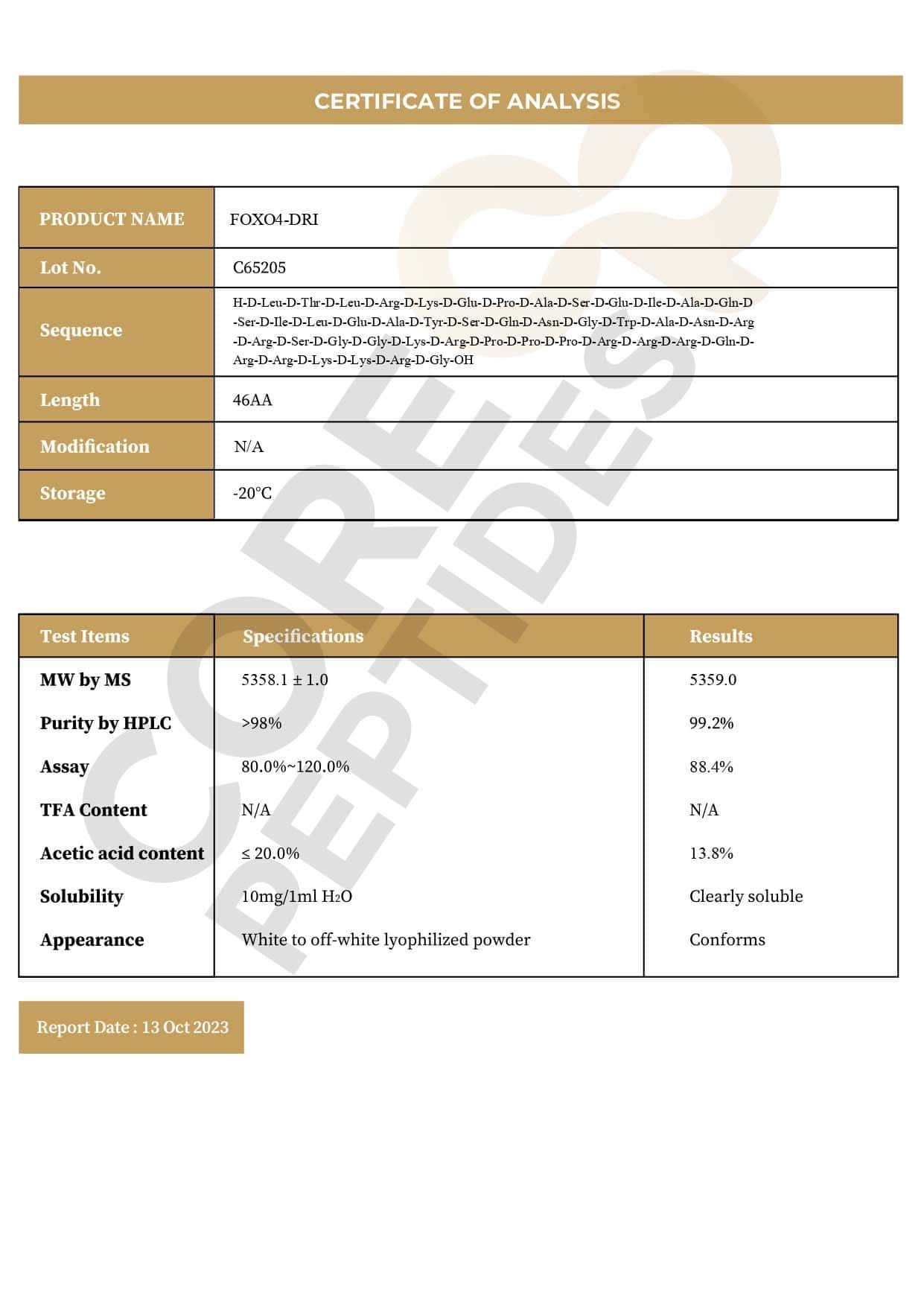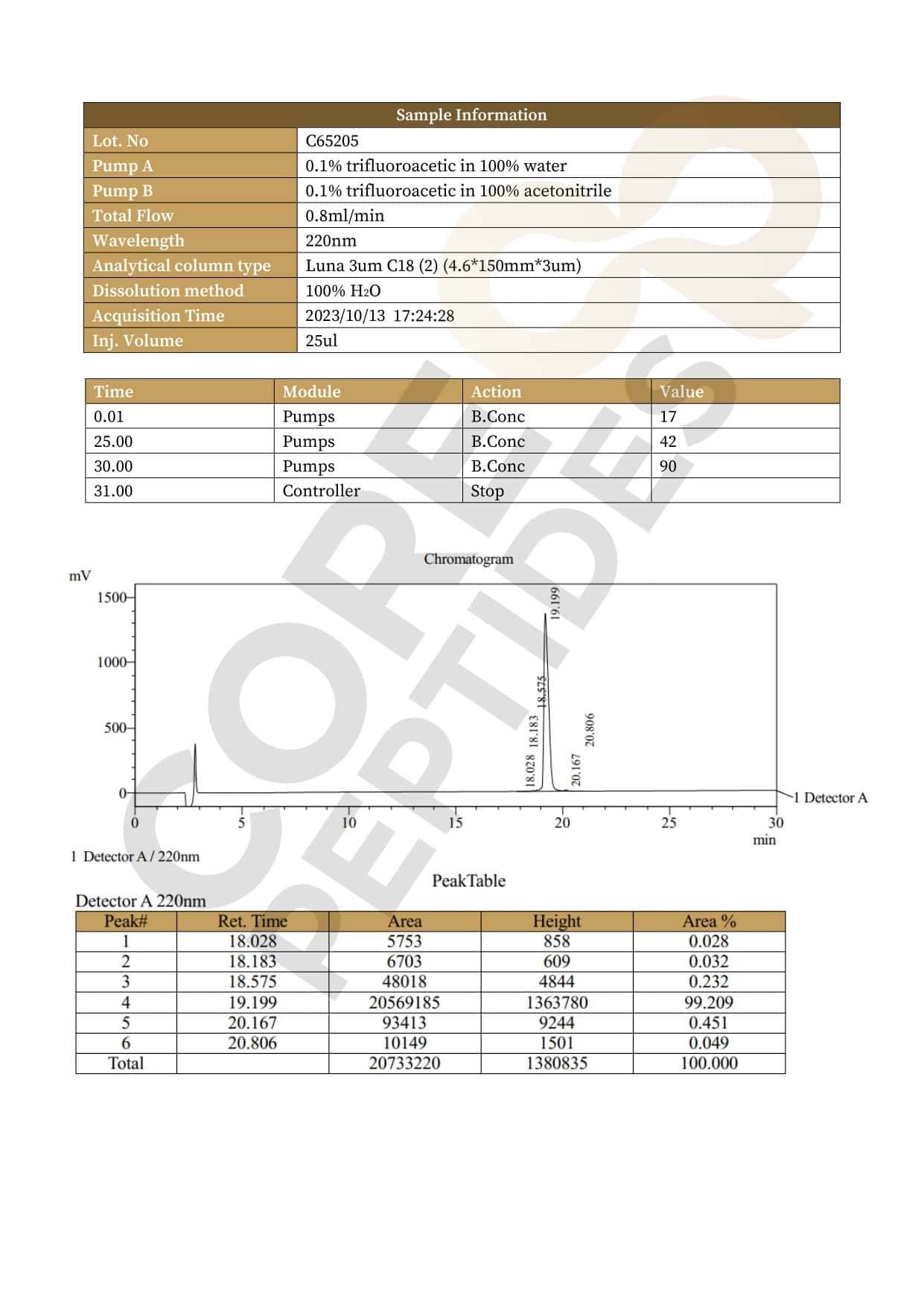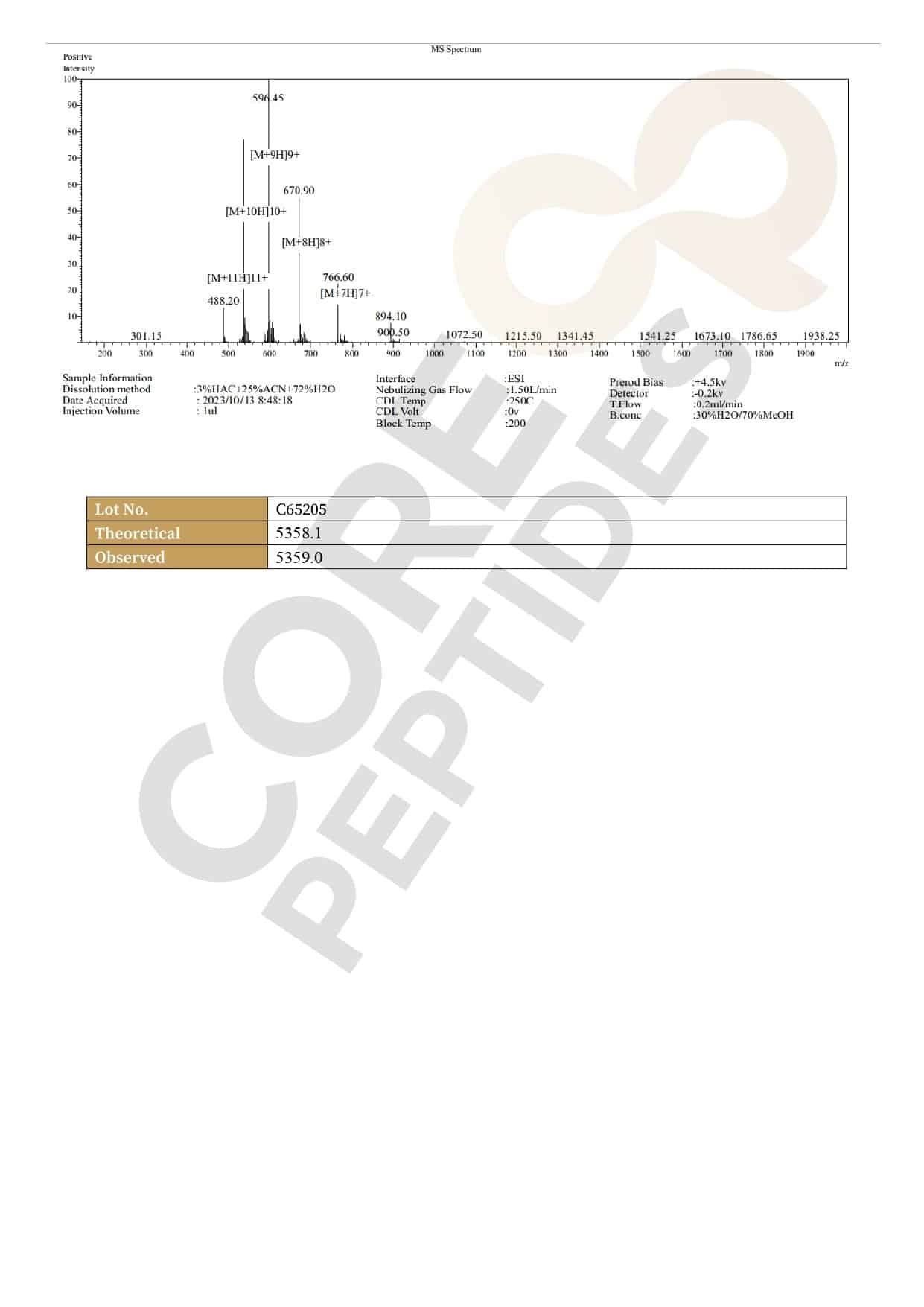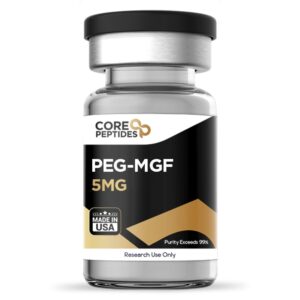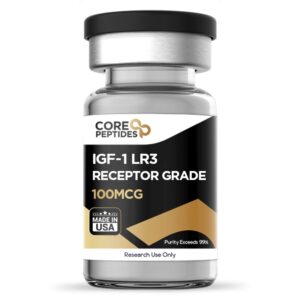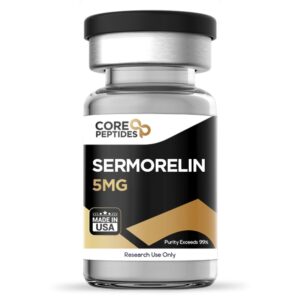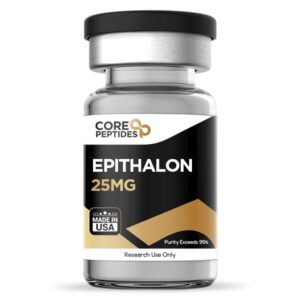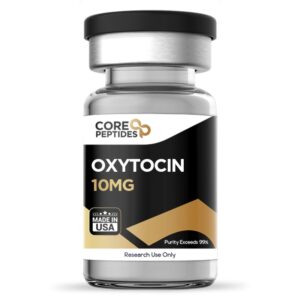FOXO4-DRI (10mg)
$220.00
Size: 10mg
Contents: FOXO4-DRI (10mg)
Form: Lyophilized powder
Purity: >99%
SKU: P-FOXO4-10
FREE Shipping on $200+ orders
FREE Bacteriostatic Water (30ml) on $200+ orders
Discount per Quantity
| Quantity | Discount | Price |
|---|---|---|
| 5 - 8 | 5% | $209.00 |
| 9 + | 10% | $198.00 |
FOXO4-DRI Peptide
Organisms host multiple transcription factor proteins, one such class of transcription factor proteins is the FOXO group, or forkhead family of transcription factor-O,(2) which includes four members namely FOXO1, FOXO3, FOXO4, and FOXO6. The FOXO4 factor is considered to regulate various cell pathways including insulin signaling, and cell cycle progression, and other functions that regulate growth and differentiation.
A synthetic version of the FOXO4 protein is FOXO4-DRI, which was developed to be identical to the endogenously available FOXO4 protein, except for the alteration in its amino acid structure. FOXO4-DRI peptide, also called Proxofim, is an acronym for Forkhead box O transcription factor 4-D-Retro-Inverso peptide.(3) FOXO4-DRI peptide is the same as that of FOXO4 protein, except that the L amino acids in its structure are replaced by D amino acids. As a result of this, FOXO4-DRI peptide may be less susceptible towards the normal clearance mechanism as compared to FOXO4.
Overview
The retro inverso peptides (DRI peptides) are linear chains of amino acids, where the sequence is "reversed", reversing the chirality of the structure (i.e., L amino acid structure altered to D amino acid and vice versa). D amino acids represent the mirror image of the naturally occurring L amino acids in the biological proteins. The main potential advantage of exchanging L amino acid with D amino acid is that the latter may be more resistant towards degradation, making the protein structure more durable.
The main focus of FOXO4-DRI peptide research is focused on its potential to prevent the binding of the FOXO4 protein with p53 protein.(4) The p53 protein is an endogenous regulator protein, considered to regulate the progression of the cell cycle, including cell death. When FOXO4 protein binds with p53, it does not appear to allow p53 to bind with DNA, thereby preventing apoptosis and cell death. In the presence of FOXO4-DRI peptide, this process may be inhibited, allowing p53 to bind with DNA and thereby help the cell cycle to continue to death.
FOXO4-DRI peptide is selective in nature and only exert this potential action on cells that have become dysfunctional over time due to aging, known as the senescent cells.(4) As a result of this biological pathway, the functioning of the tissues may be improved, aiding cell growth and differentiation.
Research and Clinical Studies
FOXO4-DRI Peptide and Senescence
FOXO4-DRI peptide research indicates that the peptide may not wholly stop cell senescence, however, it does have the potential to slow down the process by possibly preventing naturally-occurring FOXO4 mediated senescence. By preventing senescence and cell damage, this peptide may increase regeneration of cells. One 2017 study(6) conducted an experiment on aged mouse models that were presented with either the protein compound or the placebo. The peptide mice apparently exhibited improved fitness, better renal functioning and increased density of fur.
FOXO4-DRI Peptide and Cardiovascular Function
Research from 2002(7) has suggested that levels of proteasome enzymes decrease over time. These enzymes are considered to play a primary role in removing cells that are identified as damaged or dysfunctional within an organism. The naturally occurring FOXO4 protein appears to regulate the levels of proteasome enzymes, but it does not necessarily help in reducing damaged cells. Studies in the FOXO4-DRI peptide suggest it may boost natural processes while possibly also eliminating dysfunctional cells.
FOXO4-DRI and Insulin Signaling
Research from 2017(9) has suggested that FOXO proteins may mediate the insulin signaling pathway, possibly regulating the inhibitory functions of insulin most involved in cell metabolism, cell cycle, oxidative stress, senescence, and aging. While studies are yet to be conducted to clearly demonstrate if and how FOXO4-DRI peptide works, it is widely suggested by researchers that the peptide may improve the downstream impact of insulin, leading to reduced blood sugar levels.
FOXO4-DRI and Neurological Function
While the pathophysiology of certain neurological diseases remains unclear, it is presumed by researchers that there are changes in the proteasome enzyme activity over time, which may lead to cognitive impairment. Research(10) has suggested that the proteasome activities are downregulated in neurological disorders. It is not known whether this downregulation is the primary cause of the disorder or not, but it is likely to be a contributing factor. Clinical research has suggested that the levels of FOXO proteins in the central nervous system may be altered in test subjects suffering from neurodegenerative disorders (NDDs).(11) This has led to the hypothesis that exogenous FOXO protein, such as FOXO4-DRI peptide, may help in regulating optimal levels of FOXO proteins and thereby prevent or alleviate the progression of any NDDs associated with this mechanism.
FOXO4-DRI Peptide and Hypogonadism
A study(12) was conducted with the purpose of exploring the potential of FOXO4-DRI peptide in age-related male late-onset hypogonadism. An in vitro model composed of senescent Leydig cells was used. These Leydig cells were previously isolated from male mice and given a hydrogen peroxide chemical to induce senescence. On analysis of these damaged cells, researchers noted that FOXO4 cells appeared to help maintain the viability of these cells and possibly prevent apoptosis. When these isolated senescence cells were presented with FOXO4-DRI peptide, researchers reported that the peptide appeared to block FOXO4 proteins, allowing p53 to bind with DNA, which led to the apoptosis of the senescent Leydig cells. Another study(12) in naturally aged mice suggested that FOXO4-DRI peptide may improve the functioning of Leydig cells.
FOXO4-DRI peptide is available for research and laboratory purposes only. Please review and adhere to our Terms and Conditions before ordering.
References:
- Babu MM, Luscombe NM, Aravind L, Gerstein M, Teichmann SA. Structure and evolution of transcriptional regulatory networks. Curr Opin Struct Biol. 2004 Jun;14(3):283-91. https://pubmed.ncbi.nlm.nih.gov/15193307/
- Sun, Yan et al. “FOXO4 Inhibits the Migration and Metastasis of Colorectal Cancer by Regulating the APC2/β-Catenin Axis.” Frontiers in cell and developmental biology vol. 9 659731. 23 Sep. 2021. https://www.ncbi.nlm.nih.gov/pmc/articles/PMC8495124/
- Huang, Yuzhao et al. “Senolytic Peptide FOXO4-DRI Selectively Removes Senescent Cells From in vitro Expanded Human Chondrocytes.” Frontiers in bioengineering and biotechnology vol. 9 677576. 29 Apr. 2021, https://www.ncbi.nlm.nih.gov/pmc/articles/PMC8116695/
- Zhang, C., Xie, Y., Chen, H., Lv, L., Yao, J., Zhang, M., Xia, K., Feng, X., Li, Y., Liang, X., Sun, X., Deng, C., & Liu, G. (2020). FOXO4-DRI alleviates age-related testosterone secretion insufficiency by targeting senescent Leydig cells in aged mice. Aging, 12(2), 1272–1284. https://www.ncbi.nlm.nih.gov/pmc/articles/PMC7053614/
- Krimpenfort P, Berns A. Rejuvenation by Therapeutic Elimination of Senescent Cells. Cell. 2017 Mar 23;169(1):3-5. https://pubmed.ncbi.nlm.nih.gov/28340347/
- Marjolein P. Baar et al, Targeted Apoptosis of Senescent Cells Restores Tissue Homeostasis in Response to Chemotoxicity and Aging. Vol 169 Issue 1, https://doi.org/10.1016/j.cell.2017.02.031
- Anne-Laure Bulteau, Luke I. Szweda, Bertrand Friguet, Age-Dependent Declines in Proteasome Activity in the Heart, Archives of Biochemistry and Biophysics, Volume 397, Issue 2, 2002, Pages 298-304, ISSN 0003-9861, https://doi.org/10.1006/abbi.2001.2663
- Murtaza G, Khan AK, Rashid R, Muneer S, Hasan SMF, Chen J. FOXO Transcriptional Factors and Long-Term Living. Oxid Med Cell Longev. 2017;2017:3494289. doi: 10.1155/2017/3494289. Epub 2017 Aug 15. https://pubmed.ncbi.nlm.nih.gov/28894507
- Lee, S., & Dong, H. H. (2017). FoxO integration of insulin signaling with glucose and lipid metabolism. The Journal of endocrinology, 233(2), R67–R79. https://www.ncbi.nlm.nih.gov/pmc/articles/PMC5480241/
- Ciechanover A, Brundin P. The ubiquitin proteasome system in neurodegenerative diseases: sometimes the chicken, sometimes the egg. Neuron. 2003 Oct 9;40(2):427-46. https://pubmed.ncbi.nlm.nih.gov/14556719/
- Wei Hu, Zhi Yang, Wenwen Yang, Mengzhen Han, Baoping Xu, Zihao Yu, Mingzhi Shen, Yang Yang, Roles of forkhead box O (FoxO) transcription factors in neurodegenerative diseases: A panoramic view, Progress in Neurobiology, Volume 181, 2019, 101645, ISSN 0301-0082, https://doi.org/10.1016/j.pneurobio.2019.101645
- Zhang, C., Xie, Y., Chen, H., Lv, L., Yao, J., Zhang, M., Xia, K., Feng, X., Li, Y., Liang, X., Sun, X., Deng, C., & Liu, G. (2020). FOXO4-DRI alleviates age-related testosterone secretion insufficiency by targeting senescent Leydig cells in aged mice. Aging, 12(2), 1272–1284. https://www.ncbi.nlm.nih.gov/pmc/articles/PMC7053614/

